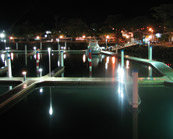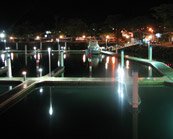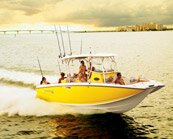Of all the electrical devices on your boat, the navigational lights are probably the most important when it comes to on-water safety. The purpose of having navigational lights on boats is so others can see your boat in the dark, and hopefully avoid running into you. The converse is true, as well—if you can see other boats’ lights, you can steer clear of them and prevent a maritime disaster.
Powerboats Under 40’, (under power)
On the port side, at the bow, a red sidelight must be displayed, while on the starboard side, at the bow, a green sidelight must be displayed. Both the red and green sidelights must be visible from straight in front of the boat and in a 112.5° arc to stern.
The red and green sidelights are often combined into a bicolor light mounted on top of the bow.
In addition, a 360° all-round white light must also be displayed either at the stern (on smaller powerboats) or on a mast above the bridge (on larger powerboats)
Powerboats Under 40’ (at anchor)
A powerboat at anchor may turn off the red and green navigational lights, and leave just the 360° all-round white light on.
Sailboats (under power)
Must also have the red and green sidelights (or a bicolor light), a white stern light that shines aft and 67.5° on either side of the boat.
Sailboats (at anchor)
When a sailboat anchors at night, it must display a 360° all-round white light.
These are simply the high points of navigation lights; please consult with the US Coast Guard for up-to-the-minute rules and regulations.


